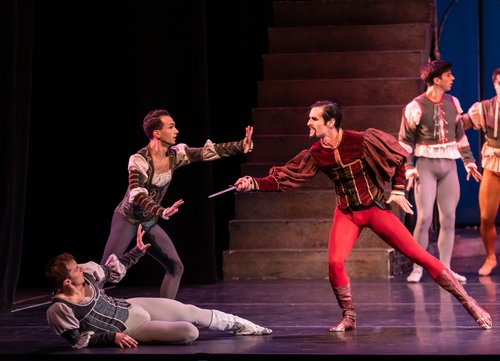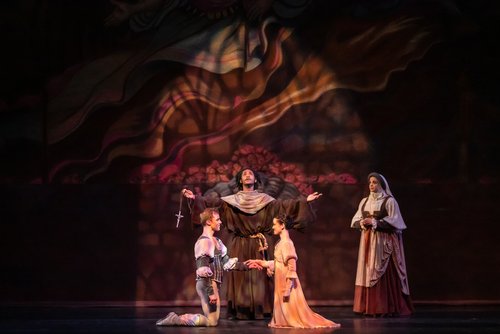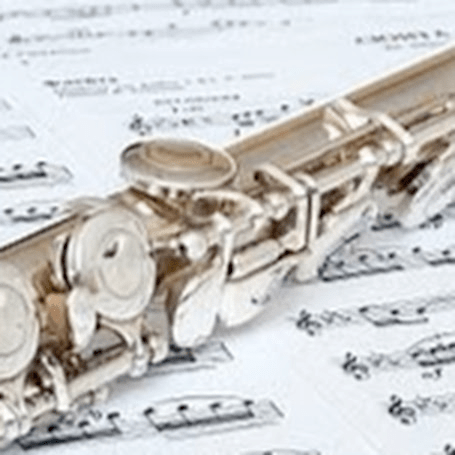Total Art at the Nashville Ballet: Vasterling, Prokofiev, and more
Paul Vasterling’s Romeo and Juliet is definitely a tour de force. As he reveals in the pre-performance video, his intent was to create balance between narrative and dance, between movement and metaphor. But also, there seems to be an impetus toward Wagnerian Gesamtkunstwerk, a blending of art forms into a total unified whole.

For the most part, this vision was achieved. Complementary moments of delight and compelling drama emerged from the union of choreography, sets, staging, lights, and coordination with the music.
Choreographically, Vasterling skillfully embraced the exuberance of the title characters. Romeo (Nicolas Schauer) and his rambunctious buddies Mercutio (Michael Burfield) and Benvolio (Garrit Mc Cabe) dashed and leapt with canonic tours en l’air (spins in the air) enhanced by imaginative use of the stage’s full area. The dance of Juliet’s four bridesmaids formed an effective counterpoint to Romeo’s friends. Juliet’s graceful leaps highlighted the strength of youth while her delicate footwork expressed burgeoning maturity. Alternately embracing and frolicking, their pas de deux similarly revealed a believable mix of adolescence evolving into adulthood.
Tom Klotz’s fight scene choreographies were cleverly done, but felt overly long with one exception: Contextually, the battle between rivals Romeo and Paris (Brett Sjoblom) should have been longer. Likewise, the length of Mercutio’s death scene broke the flow of believability.
One choreographic bit of particular creativity, though, was Romeo’s dance with Juliet’s “corpse.” Although Juliet (Jamie Kopit) performed dance poses, the concept of her lifeless body was quite effective. In fact, Kopit was the most convincing as an actor, depicting both innocence and passion. Her chilly affect with Paris, for example, resonated tonally.
Choreography and sets (Studio Concepts, Inc) worked in concert in the lovely balcony scene where Romeo gracefully helps Juliet down from greenery-strewn boulders. Lighting, sets, and staging worked in mutual harmony, especially in the tomb scene décor. The muted lighting and the cross in a grate suspended at an angle was inspired. The entry of Friar Lawrence with the low brass showed the powerful effect of music’s contribution, reminiscent of the “Dies Irae” in Berlioz’ Symphonie Fantastique.

Two other surprises came from the music, ably conducted by Ming Luke, Principal Conductor for Nashville Ballet. Because I had only ever heard Prokofiev’s orchestral suites from the ballet where he trimmed back the orchestration, the pair of mandolins was a surprise. They gave a nice sense of Italian folk music. Similarly, I had not been aware that the Gavotte, best known as a movement from the composer’s charming Classical Symphony written in 1917, had been repurposed here for this 1935 work.
There were times, however, when the desired artistic whole splintered a bit, especially in terms of costuming and historical context. In the marketplace scenes, there was an odd disconnect between the numbers of village women and noblemen. And though both Lord and Lady Capulet (Daniel Rodriguez and Claudia Monja) were the height of elegance, dresses for women of both Capulet and Montague clans were unnecessarily long and unwieldy, limiting their mobility. Interestingly, though the older women were overdressed, Juliet wore the same bare-bones costumes in her bedroom in front of both her nurse, parents, and, inappropriately, Paris, the young man her parents had chosen for her. Even a cloak would have made a difference as that costume remained in the runaway to Friar Lawrence and in the tomb scene.
One inexplicable annoyance was bumping, scraping, and other set change noises which broke the continuity. As for the usher staff, they should stop allowing late patrons to enter during dramatic scenes. There is little more disruptive than a patron climbing over you, blocking your view, as Juliet is carried to her tomb.
In past reviews, I have noted Vasterling’s apparent attempt to redress over a hundred years of focus on the prima ballerina to the detriment of the principal danseur. In Firebird, for example, the Prince’s role was emphasized to the point of imbalance. In Romeo and Juliet, however, the balance was fairly consistent, although the role of Amante (Marissa Stark), Mercutio’s lover, seemed out of balance. Stark’s dancing was exciting and well-choreographed, but from the standpoint of the storyline, other characters are more vital to the narrative. But these are relatively small points.
One mark of the production’s success is how it kept the audience enthralled, despite its longer-than-average ballet length of 2½ hours. This success was due, in large part, to the masterful breadth Vasterling showed in the nearly seamless pairing of his choreographic imagination with this great musical work and the other necessary art forms, creating a satisfying whole. Nashville Ballet returns on May 12-23 with Live in Studio A, an up-close look at the beauty and athleticism of dance, featuring brand-new works by Nashville Ballet company dancers both past and present, including Julia Eisen, Aeron Buchanan, Anneliese Guerin, and Imani Sailers, plus a world premiere by Artistic Director Nick Mullikin,



